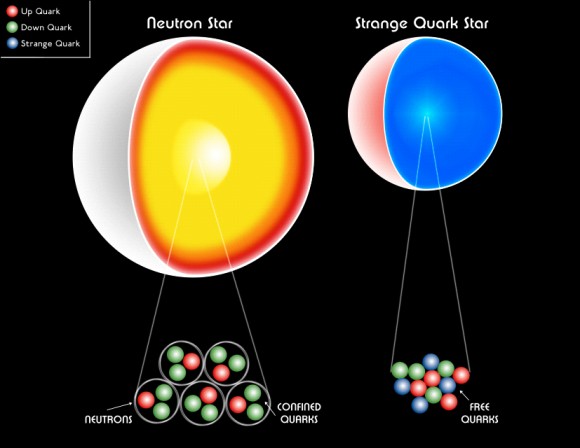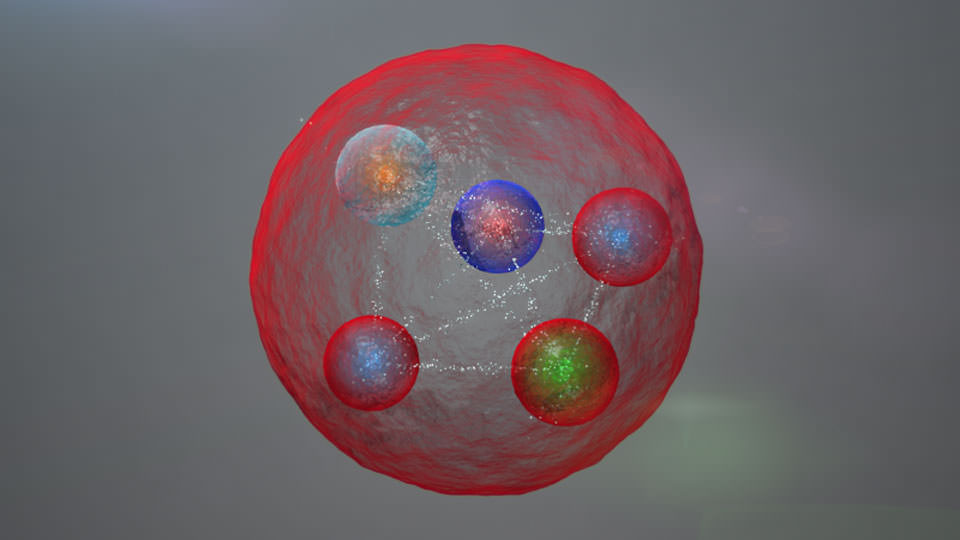“Three quarks for Muster Mark!,” wrote James Joyce in his labyrinthine fable, Finnegan’s Wake. By now, you may have heard this quote – the short, nonsensical sentence that eventually gave the name “quark” to the Universe’s (as-yet-unsurpassed) most fundamental building blocks. Today’s physicists believe that they understand the basics of how quarks combine; three join up to form baryons (everyday particles like the proton and neutron), while two – a quark and an antiquark – stick together to form more exotic, less stable varieties called mesons. Rare four-quark partnerships are called tetraquarks. And five quarks bound in a delicate dance? Naturally, that would be a pentaquark. And the pentaquark, until recently a mere figment of physics lore, has now been detected at the LHC!
So what’s the big deal? Far from just being a fun word to say five-times-fast, the pentaquark may unlock vital new information about the strong nuclear force. These revelations could ultimately change the way we think about our superbly dense friend, the neutron star – and, indeed, the nature of familiar matter itself.
Physicists know of six types of quarks, which are ordered by weight. The lightest of the six are the up and down quarks, which make up the most familiar everyday baryons (two ups and a down in the proton, and two downs and an up in the neutron). The next heaviest are the charm and strange quarks, followed by the top and bottom quarks. And why stop there? In addition, each of the six quarks has a corresponding anti-particle, or antiquark.

An important attribute of both quarks and their anti-particle counterparts is something called “color.” Of course, quarks do not have color in the same way that you might call an apple “red” or the ocean “blue”; rather, this property is a metaphorical way of communicating one of the essential laws of subatomic physics – that quark-containing particles (called hadrons) always carry a neutral color charge.
For instance, the three components of a proton must include one red quark, one green quark, and one blue quark. These three “colors” add up to a neutral particle in the same way that red, green, and blue light combine to create a white glow. Similar laws are in place for the quark and antiquark that make up a meson: their respective colors must be exactly opposite. A red quark will only combine with an anti-red (or cyan) antiquark, and so on.
The pentaquark, too, must have a neutral color charge. Imagine a proton and a meson (specifically, a type called a J/psi meson) bound together – a red, a blue, and a green quark in one corner, and a color-neutral quark-antiquark pair in the other – for a grand total of four quarks and one antiquark, all colors of which neatly cancel each other out.
Physicists are not sure whether the pentaquark is created by this type of segregated arrangement or whether all five quarks are bound together directly; either way, like all hadrons, the pentaquark is kept in check by that titan of fundamental dynamics, the strong nuclear force.
The strong nuclear force, as its name implies, is the unspeakably robust force that glues together the components of every atomic nucleus: protons and neutrons and, more crucially, their own constituent quarks. The strong force is so tenacious that “free quarks” have never been observed; they are all confined far too tightly within their parent baryons.
But there is one place in the Universe where quarks may exist in and of themselves, in a kind of meta-nuclear state: in an extraordinarily dense type of neutron star. In a typical neutron star, the gravitational pressure is so tremendous that protons and electrons cease to be. Their energies and charges melt together, leaving nothing but a snug mass of neutrons.
Physicists have conjectured that, at extreme densities, in the most compact of stars, adjacent neutrons within the core may even themselves disintegrate into a jumble of constituent parts.
The neutron star… would become a quark star.

Scientists believe that understanding the physics of the pentaquark may shed light on the way the strong nuclear force operates under such extreme conditions – not only in such overly dense neutron stars, but perhaps even in the first fractions of a second following the Big Bang. Further analysis should also help physicists refine their understanding of the ways that quarks can and cannot combine.
The data that gave rise to this discovery – a whopping 9-sigma result! – came out of the LHC’s first run (2010-2013). With the supercollider now operating at double its original energy capacity, physicists should have no problem unraveling the mysteries of the pentaquark even further.
A preprint of the pentaquark discovery, which has been submitted to the journal Physical Review Letters, can be found here.


Are photons made of quarks? Matter can be converted into radiation (e.g., annihilation reactions), and radiation can be converted into matter (e.g., pair production). So what happens to the quarks? That which is truly fundamental cannot be converted into something else.
I think this kind of physics (and astronomy) is way off into the weeds. (Maybe we should call it “quack” physics.) We certainly need something a lot better than this!
No, photons are fundamental particles, as are electrons, neutrinos and, I think, the Higgs. Rather than saying quarks are converted into photons in annihilation events I think it’s more accurate to say the quarks literally cease to be and the photons are the product of the energy released in a new form.
The idea of a fundamental particle is something that can’t be divided into smaller components, but as everything seems to be a form of energy I don’t see that conversion to another form needs to be a problem.
And of course the bottom line is that it seems to be borne out by observation.
So it sounds like energy is a more fundamental concept.
And so what about gravitons? Are they made of quarks? Energy?
It just seems like modern physics wants to explain everything in terms of “particles” no matter how bizarre the concepts get.
The only things made of quarks are protons, neutrons and now these pentaquarks. Quarks are just one of the set of fundamental particles. Read the article, it explains things very well. And the reason things are explained in terms of particles is that it fits with SOME observations. Other observations imply the same things look like waves. And bizarre? Yes the universe is bizarre.
I did a search on “how many fundamental particles are there?”. The first listed response gave a table of “All 61 confirmed elementary particles in the Standard Model”.
Calling all these particles “elementary” or “fundamental” is outright EMBARRASSING. I am amazed physicists can subscribe to this view and not have a very red face!
Physicists say the Universe is “elegant” and that the math is “beautiful”. It is bizarre only when it is not understood.
How many femto-seconds does the pentaquark last?
Is it correct to assume that the theoretical ‘strange quark star’ would be the densest possible form of matter outside of a black hole? Time to start thinking about the conventional standard measures of these things such as how much a sugar cube’s worth would weigh, and how big the Sun would be if it was made of the same material.
I don’t believe there are quarks like they say. But if there were quarks then a Neutron star would look something like the picture they have for the ‘quark star’ (a tight spherical pack like a bag of marbles).
They think neutrons would have “confined quarks” (shown in the picture with a spherical encasement)?
What is making that spherical encasement and holding the quarks at a distance from each other? Magic?
That magic has a name: gluons